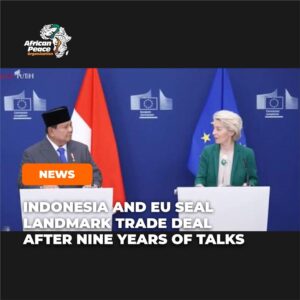Indonesia and EU Seal Landmark Trade Deal After Nine Years of Talks
Pact expected to double trade flows, cut tariffs, and boost green investment despite environmental concerns
Indonesia and the European Union have concluded a landmark trade agreement after nearly a decade of negotiations, opening a new chapter in economic ties between Southeast Asia’s largest economy and one of the world’s biggest trading blocs.
The Indonesia–European Union Comprehensive Economic Partnership Agreement (IEU-CEPA) was formally signed on Tuesday in Bali by EU Trade Commissioner Maros Sefcovic and Indonesia’s Coordinating Minister for Economic Affairs Airlangga Hartarto.
The pact makes Indonesia only the third Southeast Asian country, after Singapore and Vietnam, to reach such a deal with Brussels.
“By finalising this agreement, the EU and Indonesia are sending a powerful message to the world that we stand united in our commitment to open, rules-based and mutually beneficial international trade,” Sefcovic said at the ceremony.
European Commission President Ursula von der Leyen added in a statement that EU exporters will save an estimated €600 million ($708 million) annually in duties once the deal takes effect, making European products more affordable for Indonesian consumers.
“By finalising this agreement, the EU and Indonesia are sending a powerful message to the world that we stand united in our commitment to open rules-based and mutually beneficial international trade,” Sefcovic said after the signing.
“In all, EU exporters will save some 600 million euros ($708 million) a year in duties paid on their goods entering the Indonesian market, and European products will be more affordable and available to Indonesian consumers,” he added.
Under the agreement, nearly 80 percent of Indonesian exports to Europe, including palm oil, fisheries, textiles, footwear, and electric vehicle components will enjoy duty-free access.
European exporters will in turn benefit from reduced tariffs on machinery, vehicles, food products, and high-tech equipment.
The deal is also expected to attract significant European investment in Indonesia’s strategic sectors such as renewable energy, electric vehicles, electronics, and pharmaceuticals.
Trade between the two partners was valued at US$30.1 billion in 2024, and officials project that figure could double within five years of the agreement’s implementation. The pact is expected to be ratified in 2026 and take effect on January 1, 2027.
While widely welcomed, the deal has also raised concerns. Environmental groups warn it could weaken enforcement of EU deforestation rules, particularly around palm oil, while Indonesian industry leaders fear stiff competition from European imports.
Both sides will also need to address long-standing issues around non-tariff barriers, labor standards, and regulatory compliance to ensure smooth implementation.
Despite these challenges, analysts say the agreement signals a strong commitment to open markets at a time when global trade is increasingly strained by protectionism and geopolitical tensions.
For Indonesia, it offers the chance to boost exports by as much as 50 percent within the next four years, while for the EU, it secures access to one of Asia’s fastest-growing markets and vital supply chains for green technologies.
Asian Markets Subdued as Traders Await U.S. Inflation Data Amid Government Shutdown Risk
Caution prevails after Wall Street records as investors eye Fed signals, PCE report, and political deadlock in Washington
Asian markets traded cautiously on Tuesday, September 23, as investors looked ahead to key U.S. inflation data that could shape Federal Reserve policy, while concerns over a looming government shutdown in Washington weighed on sentiment.
The muted performance came after Wall Street closed at fresh record highs, extending a rally fuelled by optimism over monetary easing following last week’s interest rate cut.
Fed policymakers projected two more cuts before the end of the year to support a stuttering labor market, but attention is now fixed on Friday’s release of the personal consumption expenditures price index, the central bank’s preferred inflation gauge, for clearer signals on the pace of policy adjustments.
In Asia, trading was subdued by a holiday in Japan and storm warnings in Hong Kong. Markets in Hong Kong, Shanghai, Manila and Wellington slipped, while Sydney, Seoul, Singapore and Jakarta posted modest gains.
Taipei outperformed, climbing more than one percent as chip giant TSMC surged nearly three percent, tracking U.S. tech peers after Nvidia announced a $100 billion investment in OpenAI to drive next-generation artificial intelligence.
Despite the positive momentum from technology stocks, analysts warned that recent rallies may have stretched valuations, leaving markets vulnerable to a pull-back.
“There are rickety bridges ahead. The US government shutdown drama remains unresolved, another potential rockslide on the tracks,” said SPI Asset Management’s Stephen Innes.
“The Senate’s failure to bridge the gap between competing proposals leaves traders watching the Sept. 30 deadline with one eye, even as the other scans record-high tickers.
“Markets rarely derail on the first warning, but complacency can turn into chaos when the train rounds a blind corner.”
In Washington, the Senate failed to advance a stopgap funding bill after the Republican-controlled House narrowly passed its own version.
With both chambers set for recess next week, time is running out to avoid a shutdown when the fiscal year ends on September 30.
A closure would halt many non-essential government functions and leave hundreds of thousands of federal workers without pay, a scenario that could ripple through financial markets already wary of political brinkmanship.
The U.S. dollar paused after recent gains, while gold strengthened on safe-haven demand. Investors also digested new projections from the Organisation for Economic Co-operation and Development, which forecast U.S. economic growth slowing to 1.8 percent in 2025 and 1.5 percent in 2026, cautioning that the full impact of recent U.S. tariffs had yet to be felt.
With markets on edge, traders are balancing optimism over Federal Reserve support against unresolved risks from inflation, political stalemate in Washington and signs of slowing global growth.
Meanwhile, the focus remains on whether Friday’s U.S. inflation data confirms a sustainable path lower, providing cover for further rate cuts, or delivers an unwelcome surprise that could unsettle both Wall Street and Asia’s trading floors.
Source: Reuters





